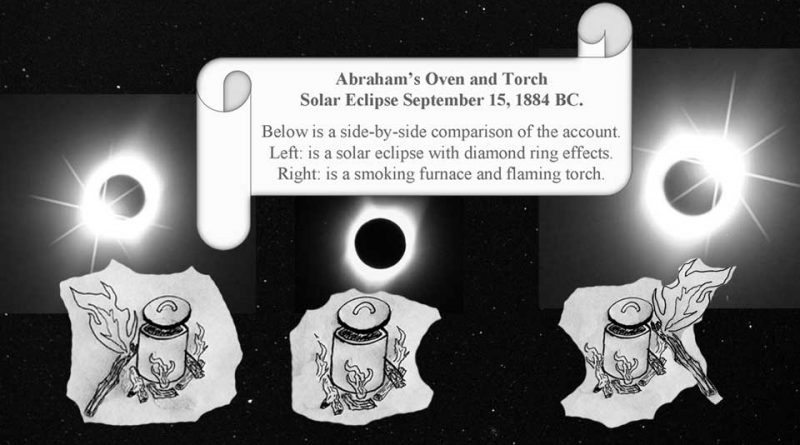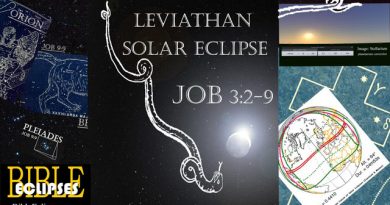Abraham Solar Eclipse 15 September 1884 BC
The night of September 14, 1884 BC, had no moon the entire night, making it very dark. During the darkness, God communed with Abraham:
Genesis 15:13-16 – “God said unto Abram, know of a surety that thy seed shall be sojourners in a land that is not theirs, and shall serve them; and they shall afflict them four hundred years; and also that nation, whom they shall serve, will I judge: and afterward shall they come out with great substance. But thou shalt go to thy fathers in peace; thou shalt be buried in a good old age. And in the fourth generation they shall come hither again: for the iniquity of the Amorites is not yet full.”
On the night of September 14, 1884 BC, through the morning of September 15, 1884 BC, Abraham counted four planets. At the moment of complete darkness, three planets, Venus, Jupiter, and Mars, would have been visible. By the end of the evening, Saturn would have come into view as well. A total of four planets were visible during the complete darkness that night. On this night, the moon and Mercury were not visible because they were close to the sun.
The four planets that Abraham counted each represent a generation. These four planets were known as wandering stars, because they behaved differently from all the other stars. Today, the wandering stars are called planets. The planets do not stay in one assigned location among the constellations. The planets change location continually without ceasing. On one day, Mars can be seen in the constellation Orion, and then on another night, Mars could be seen in Aquarius. All the planets have the same unique characteristics. This visual goes along exactly with what God had said. God told Abraham that his “seed shall be sojourners in a land that is not theirs” and then in “the fourth generation they shall come hither again.” The visual of four stars sojourning continuously forever symbolized the four generations that would not know a permanent home.
The six wandering stars of Abraham’s day were Mercury, Venus, Mars, Jupiter, Saturn, and the moon. Josephus tells us that Moses designed the candlestick that goes in the temple based on six planets and the sun: “the seven lamps signified the seven planets; for so many there were springing out of the candlestick.”[1] The Israelites considered the sun as a planet. Josephus offered further explanation of this fact: “…spread itself into as many branches as there are planets, including the sun among them.”[2] Amos expounds upon this to include heavenly forms: “Seek him that maketh the Pleiades and Orion, and turneth the shadow of death into the morning, and maketh the day dark with night” (Amos 5:8). God created the seven stars, constellations, and also total solar eclipses. Hence “maketh the day dark with night.”
Abraham would have noticed four planets in the sky. At the beginning of the darkness, three planets were visible. At the end of the night, roughly one hour before sunrise, the last planet rose just over the constellation Virgo—symbolizing the sojourning of four generations.
A generation is subjective, but 400 years is a set amount of time. The four generations are a symbolic representation of 400 years. At the time of Abraham, a generation would be roughly 100 years. For instance, Abraham was 100 years old when he had his son Isaac, Jacob was 91 years old when he had Joseph, and Joseph died at 110 years old. The Bible states that Abraham’s children would be sojourners for 400 years, making these 400 years a definite timeframe. God then informs us that after four generations, Abraham’s ancestors would return to the Promised Land. These timeframes must be equal, so by dividing 400 by four generations, we get 100 years for each generation. This may not mean there must be precisely one hundred years between each generation of parents and children or that each individual would live for precisely 100 years. Instead, a total period of roughly four generations a total of 400 years would pass.
God told Abraham, “Also that nation, whom they shall serve, will I judge: and afterward shall they come out with great substance” (Genesis 15:14). The moment God spoke these words, the night ended as the last planet started rising just above the constellation Virgo. The constellation Virgo marked the time of year that crops were harvested. Mid-September is when one’s hard work is rewarded with a harvest that would bring wealth for their work, once again symbolizing that the fourth generation would receive wealth for their labor.
The night ended; however, the sun was about to go dark one last time. The rising of Virgo marked the end of the night that must have felt like a “horror of great darkness.” The night lasted roughly 11 hours and must have felt like an eternity. The sun entered a noticeable eclipse at sunrise that climaxed in a 92% to 100% solar eclipse (depending on his location, which is unknown). The eclipse is recorded in the following verse, “It came to pass, that, when the sun went down, and it was dark, behold, a smoking furnace, and a flaming torch that passed between those pieces” (Genesis 15:17).
The second event, An eclipse of the sun at sunrise, matches Scripture.
A deeper understanding of what Abraham saw can be gained by understanding what an “oven” is. George A. Barton wrote about this oven in his book. He stated, “Each consist of a cylinder of baked earth about 2 feet in diameter and 1 1/2 inches thick. It is closed by a cover of the same material, in which a stone or lump of clay has been embedded as a handle. There is rarely any bottom except the bare earth. The loaves which were flat discs, were usually placed inside, either on the ground covered with clean pebbles or on a baking-tray.” He goes on to state, “the fire was usually heaped about the outside of the oven.”[2]
There are three critical things about the archeological descriptions of the oven. First, it is round in shape when standing over it, looking directly down on the oven. Second, the fire would be outside the oven, so any light from the fire will illuminate the outside, not the inside. Third, the oven center will be dark because the fire is outside the oven. A ring of smoke and fire can be seen as a result of the fire outside the oven.
The description of a smoking oven and torch matches the description of the solar eclipse. Ellicott believes that Abraham witnessed a total solar eclipse: “The terror was not mental so much as bodily, caused by a deep gloom settling round him, such as would be the effects of an eclipse of the setting sun, and shutting all mortal things away from his view.”[3] Ellicott has Genesis 15:12 and 15:17 occurring at the same time. The Scripture does not provide any indication that the two recorded events are the same event. A literal reading of the Scripture would place the events of Genesis 15:12 and 15:17 in series, hence following each other—not cooccurring. With that said I agree with Ellicott’s theory that Abraham is describing a solar eclipse in Genesis 15:17.
Over 4,000 years ago, people did not understand what caused a solar eclipse, let alone that they existed. The Hebrew language did not have a word for a total solar eclipse, making it impossible to relay what Abraham had seen in a meaningful language outside of symbolism. Abraham compared the total solar eclipse to something he and others of his time understood: a smoking oven and a torch.
A side-by-side comparison of Abraham’s experience and the total solar eclipse of September 15, 1884 BC, will show their similarities.
- Abraham – “When the sun was going down, a deep sleep fell upon Abram; and, lo, a horror of great darkness fell upon him” (Genesis 15:12).
- Night of September 14, 1884 BC – For 11 hours darkness covered Abraham, no light not even the moon.
- Abraham – “It came to pass, that, when the sun went down, and it was dark, behold, a smoking furnace, and a flaming torch that passed between those pieces” (Genesis 15:17).
- Eclipse of September 15, 1884 BC – The sun rose in the morning, but it went into a solar eclipse. At the time of a total solar eclipse, the moon is substantially in front of the sun, blocking the sunlight. The moon appears as a dark circle void of all light. A sliver of the sun could be seen that started at the lower left of the moon and then passed by way of the upper left side of the moon and exited on the upper right of the moon.
The side-by-side comparison of Abraham’s experience and a total solar eclipse shows that Abraham’s description is similar to the morning eclipse.
[1] Josephus, Translated by Whiston, The Works of Flavius Josephus: Wars of the Jews (London: John Bumpus, 1828), 5.5.5, p. 718.
[2] Josephus, Translated by Whiston, The Works of Flavius Josephus: Antiquities of the Jews (London: John Bumpus, 1828), 3.6.7, p. 89.
[2] George A. Barton, Archeology and the Bible. (Philadelphia: American Sunday-School Union) p. 190.
[3] Payne Smith, Edited by John Ellicott, A Bible Commentary for English Readers, Vol. I, Book of Genesis (New York: Cassell, 1882) p. 67.



